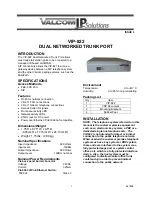
Section 311-580-20B
030-101527 Rev. B
12
0407IBRB
CAUTION
When disconnecting test equipment from the bantam jacks or the Craft Interface
port, apply pressure on the unit front panel to hold the unit in the assembly. Failure
to do so may cause the unit to be removed from service while disconnecting test
equipment.
Pin 3 - RxD (Receive Data-IN)
Pin 2 - TxD (Transmit Data-OUT)
Figure 10. Front Panel RS-232 (DB-9) Pin Assignments
Pin 5 - SGN (Signal Ground)
data for retrieval purposes, and allows maintenance, circuit
troubleshooting and set up procedures.
7.1.3
Test Points
The 3115-80 contains two test point jacks for measuring the span
current.
TP1 & TP2
Allows for measuring span current using a DC
voltmeter. TP1 will read positive with respect to
TP2. A voltmeter reading of 0.6VDC equates to
a 60mA span.
7.1.4
Status LEDs
The multi-function status LEDs on the front panel provide a
visual indication of various maintenance and alarm conditions.
The LED colors, states, and conditions are listed in Table 5.
LED
LED
Color
LED
State
STATUS LED Description
PWR
Green
On
Power is applied and present to the unit.
Off
Power not applied.
LB
Y ll
On
Unit is in Loopback.
Yellow
Flashing
Unit is armed and ready to detect the addressable
LB code.
Blinking*
Unit is in dual loopback.
Off
Unit is not in any loopback condition.
FLOS
Green
On
Signal is detected from the network.
Red
On
Signal from the network to the unit is lost.
CLOS
Green
On
Signal is detected from the customer.
Red
On
Signal from the customer is lost.
ESF
Green
On
Unit has detected ESF framing from the network.
Off
Unit is detecting SF/unframed signals from the
network.
B8ZS
Green
On
Unit is configured for B8ZS line coding.
Off
Unit is configured for AMI line coding.
*The on/off cycle of a flashing LED is faster than a blinking LED.
Table 5. Front Panel LED Conditions and States
7.1.5
Push Button Switch, MAN LB
The NIU loopback state can be controlled by pressing the front-
panel MAN LB push button. Depression of the MAN LB push
button will cycle through the loopback states.
SPAN
LOC
Top Edge of PCB
Edge Connector (56-pin) of PCB
Figure 11. NIU Powering Option Location
Middle of Side-panel’s
Printed Circuit Board
Gray/shaded rectangle is
the pin jumper.
P201
When first depressed, the LB LED will go off and remain
off during the first 3 seconds that the MAN LB is depressed.
If released during this 3 second period, all existing loopback
conditions will be deactivated.
If depressed for 3 to 5 seconds, the LB LED will be on solid
(Green). If released in this interval, the Network Loopback
will be activated.
If depressed for greater than 5 seconds, the LB LED will be-
gin flashing (Green). If released after 5 seconds, the Dual
Loopback will be activated.
7.2
PCB Power Options (Side Panel)
The unit has a powering option capability (pin headers on the
PCB, making connection via a push-on pin jumper) to configure
the unit for the proper powering operation. A jumper is pro-
vided to allow the installer to select either Span or Local
powering. If Span power is desired, mount the jumper over the
left two rows of pins on header P201. If Local power is desired,
mount the jumper over the right two columns of pins on header
P201. The location of this option is shown in Figure 11.
8.
INSTALLATION
Installation consists of inspecting the equipment for damages,
following proper safety precautions, mounting the unit in the
proper slot of the mounting assembly, and verifying the presence
of power and signalling as indicated by the status LEDs. The fol-
lowing paragraphs provide detailed instructions for performing
these procedures.
8.1
Following Safety Precautions
Before installing the NIU, observe the following safety notes.
- INSPECTION NOTE -
Visually inspect the unit for damages prior to installation: if dam-
aged in transit, immediately report the damage to the transporta-
tion company and to Westell (see Part 11 for telephone number).
CAUTION - STATIC-SENSITIVE
This product contains static-sensitive components! Follow
proper electrostatic discharge procedures to maintain
personal and equipment safety. Do not store units near
magnetic, electromagnetic or electrostatic fields. Always
store or ship units in the original static-protective packaging
from Westell. Use anti-static mats when working on units.












































